Bio
Courses I teach
ENGL 3300: Science Fiction
ENGL 3390/5220: Literary Theory
ENGL 3470: Afrofuturism
ENGL 4200: History of the English Language
ENGL 1500/2500: Written, Oral, Visual, and Electronic Communication
Degrees
PhD, English, Ohio State University
MA and B.A., English, University of Cincinnati
BA, Philosophy, University of Cincinnati
Current research areas
Science fiction; mobilities and transportation in literature
About my teaching
I believe in the value of going on a voyage of learning with my students. In my classes, I often teach texts and material that are new to me because I love to learn about them along with my students. I am fine with not being “the expert” in the room, and love approaching a text along with my students with more questions than answers, and more of a sense of curiosity than of certainty.
Recent publications
- “Disrupting the Nascent Paradigm of Urban Automobility in H.G. Wells’s The Sleeper Awakes.” The Journal of the Fantastic in the Arts 34, no. 1 (2023).
- “Automobility Without Automobiles: Boats, Airships, and Walking in Kim Stanley Robinson’s New York 2140.” Science Fiction Studies 49, no. 3: 443-458.
- “The Liberating Bicycle in Literature.” In The Routledge Handbook on Cycling, ed. Glen Norcliffe et al. (London: Routledge, 2022): 505-513.
- “Better to Move by Foot or Slidewalk: Post-Automobile Environments in Asimov’sThe Caves of Steel and Clarke’s The City and the Stars.” Extrapolation 62, no. 2 (2021): 111-131.
- Futuristic Cars and Space Bicycles: Contesting the Road in American Science Fiction (Liverpool University Press, 2020; paperback, 2023).
Current research
I study the relationship between science fiction and transportation politics. I am fascinated by what science fiction teaches us about which kinds of mobility practices and technologies of movement are more equitable, restorative, and sustainable. More specifically, much of my recent research focuses on science-fictional representations of what I call “post-automobile cities”: futuristic cities in which automobiles no longer dominate urban space and urban lives. Recent articles of mine analyze how writers like H. G. Wells, Isaac Asimov, and Arthur C. Clarke present useful and important visions of cities that have rejected the paradigm that automobiles should constitute the primary means by which people move around. In another recent article, I examine how the writer Kim Stanley Robinson uses a depiction of a flooded, post-automobile New York City (but one brimming with automobile-like boats) to warn us about how automobility is a menacing ideology that has grown so vast and complex that it encompasses much more than just materially existing cars. I am interested in how all these authors portray people using airships, moving sidewalks, zip lines, bicycles, or even simple walking in place of cars for their mobility needs. In sum, in much of my research I focus on science fiction’s value as a site for thinking through the dystopian and utopian possibilities of our daily movement and travel.
Outside of the university
When I am not working on my teaching or research, I am often playing with my son and daughter, riding my bike, looking at birds, practicing my guitar, or cooking up delicious vegetarian food with my wife.

